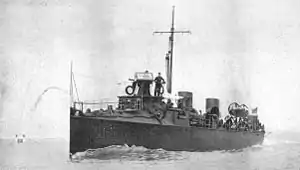HMS Hunter (1895)
HMS Hunter was one of three Handy-class destroyers built for the Royal Navy in the 1890s. Completed in 1896 she spent her career in home waters and was sold for scrap in 1912.
 HMS Hunter | |
| History | |
|---|---|
| Name | Hunter |
| Builder | Fairfield Shipbuilding and Engineering Company, Govan |
| Laid down | 7 June 1894 |
| Launched | 28 December 1895 |
| Completed | May 1896 |
| Fate | Sold for scrap, 1912 |
| General characteristics | |
| Class and type | Handy-class destroyer |
| Displacement | 275 long tons (279 t) |
| Length | 197 ft 3 in (60.1 m) (o/a) |
| Beam | 19 ft 5 in (5.9 m) |
| Draught | 7 ft 6 in (2.3 m) |
| Installed power |
|
| Propulsion | 2 triple-expansion steam engine |
| Speed | 27 knots (50 km/h; 31 mph) |
| Range | 1,270 nautical miles (2,350 km; 1,460 mi) at 11 knots (20 km/h; 13 mph) |
| Armament | |
Description
Ordered as part of the 1893–1894 Naval Programme, the Hardy-class torpedo boat destroyers were Fairfield Shipbuilding and Engineering Company's first such ships.[1] They displaced 275 long tons (279 t) at normal load and 310 long tons (310 t) at deep load. The ships had an overall length of 197 feet 3 inches (60.1 m), a beam of 19 feet 5 inches (5.9 m) and a draught of 7 feet 6 inches (2.3 m). They were powered by a pair of triple-expansion steam engines, each driving a single propeller shaft using steam provided by four Thornycroft water-tube boilers. The engines developed at total of 4,000 indicated horsepower (3,000 kW) and were intended to give a maximum speed of 27 knots (50 km/h; 31 mph).[2] During her sea trials Hunter reached a speed of 27.2 knots (50.4 km/h; 31.3 mph).[3] The Hardy's carried a maximum of 65 long tons (66 t) of coal that gave them a range of 1,270 nautical miles (2,350 km; 1,460 mi) at 11 knots (20 km/h; 13 mph).[2]
The ships were armed with a single quick-firing (QF) 12-pounder (3 in (76 mm) Mk I gun and five QF 6-pounder (2.2 in (57 mm)) Mk I Hotchkiss guns in single mounts. Their torpedo armament consisted of two rotating torpedo tubes for 18-inch (450 mm) torpedoes, one mount amidships and the other on the stern.[4]
Construction and career
Hunter was laid down by Fairfield at its Govan shipyard on 7 June 1894, launched on 28 December 1895 and completed in May 1896.[5] In 1896 Hunter was in reserve at Portsmouth.[6] In early December 1901 Wizard, tender to Excellent, the shore establishment near Portsmouth, was damaged in a collision with a tug at Portsmouth. Her crew was transferred to Hunter during repairs.[7]
She took part in the fleet review held at Spithead on 16 August 1902 for the coronation of King Edward VII.[8] The ship was sold for scrap in 1912.[9]
Notes
- Chesneau & Kolesnik, pp. 90–92
- Friedman, p. 291
- March, p. 32
- March, p. 31
- Friedman, p. 302
- "Naval Matters: Past and Prospective: The Reserve of Ships and Men". The Marine Engineer. Vol. 18. July 1896. p. 155.
- "Naval & Military intelligence". The Times. No. 36634. London. 10 December 1901. p. 10.
- "Naval Review at Spithead". The Times. No. 36847. London. 15 August 1902. p. 5.
- Chesneau & Kolesnik, p. 92
Bibliography
- Chesneau, Roger & Kolesnik, Eugene M, eds. (1979). Conway's All The World's Fighting Ships 1860–1905. London: Conway Maritime Press. ISBN 0-85177-133-5.
- Colledge, J. J.; Warlow, Ben (2006) [1969]. Ships of the Royal Navy: The Complete Record of all Fighting Ships of the Royal Navy (Rev. ed.). London: Chatham Publishing. ISBN 978-1-86176-281-8.
- Friedman, Norman (2009). British Destroyers: From Earliest Days to the Second World War. Barnsley, UK: Seaforth Publishing. ISBN 978-1-84832-049-9.
- Gardiner, Robert & Gray, Randal, eds. (1985). Conway's All The World's Fighting Ships 1906–1921. London: Conway Maritime Press. ISBN 0-85177-245-5.
- March, Edgar J. (1966). British Destroyers: A History of Development, 1892–1953; Drawn by Admiralty Permission From Official Records & Returns, Ships' Covers & Building Plans. London: Seeley Service. OCLC 164893555.